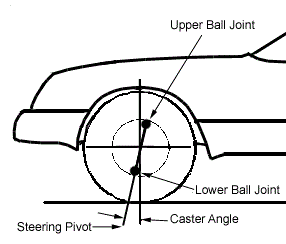Wheel Alignment
There is quite a bit of hype in the tyre world with the terms 'Super-Tracker', 'Laser alignment', ect.
To start, wheels do not move on their own accord. If the allignment was correct when the car left the factory and nothing has worn or been bent, then it stands to reason the wheels should still all be pointing in the correct direction ten years down the line.
However a lot of cars do not, and looking at the tyre wear can tell you a lot about whats wrong.
Camber

 Camber is the angle of the wheel, measured in degrees, when viewed from the front of the vehicle. If the top of the wheel is leaning out from the center of the car, then the camber is positive ,if it's leaning in, then the camber is negative. If the camber is out of adjustment, it will cause tyre wear on one side of the tyre's tread. If the camber is too far negative, for instance, then the tyre will wear on the inside of the tread.
Camber is the angle of the wheel, measured in degrees, when viewed from the front of the vehicle. If the top of the wheel is leaning out from the center of the car, then the camber is positive ,if it's leaning in, then the camber is negative. If the camber is out of adjustment, it will cause tyre wear on one side of the tyre's tread. If the camber is too far negative, for instance, then the tyre will wear on the inside of the tread.
If the camber is different from side to side it can cause a pulling problem. The vehicle will pull to the side with the more positive camber. On many front-wheel-drive vehicles, camber is not adjustable. If the camber is out on these cars, it indicates that something is worn or bent, possibly from an accident and must be repaired or replaced.
Toe (tracking)


The toe measurement is the difference in the distance between the front of the tyres and the back of the tyres. It is measured in mm's and is usually set close to zero which means that the wheels are parallel with each other. Toe-in means that the fronts of the tyres are closer to each other than the rears. Toe-out is just the opposite. And incorrect toe-in will cause rapid tyre wear to both tyres equally. This type of tyre wear is called a saw-tooth wear pattern as shown in this illustration.
If the sharp edges of the tread sections are pointing to the center of the car, then there is too much toe-in. If they are pointed to the outside of the car then there is too much toe-out. Toe is always adjustable on the front wheels and on some cars, is also adjustable for the rear wheels.
Caster
 When you turn the steering wheel, the front wheels respond by turning on a pivot attached to the suspension system. Caster is the angle of this steering pivot, measured in degrees, when viewed from the side of the vehicle. If the top of the pivot is leaning toward the rear of the car, then the caster is positive, if it is leaning toward the front, it is negative. If the caster is out of adjustment, it can cause problems in straight line tracking. If the caster is different from side to side, the vehicle will pull to the side with the less positive caster. If the caster is equal but too negative, the steering will be light and the vehicle will wander and be difficult to keep in a straight line. If the caster is equal but too positive, the steering will be heavy and the steering wheel may kick when you hit a bump. Caster has little affect on tyre wear.
When you turn the steering wheel, the front wheels respond by turning on a pivot attached to the suspension system. Caster is the angle of this steering pivot, measured in degrees, when viewed from the side of the vehicle. If the top of the pivot is leaning toward the rear of the car, then the caster is positive, if it is leaning toward the front, it is negative. If the caster is out of adjustment, it can cause problems in straight line tracking. If the caster is different from side to side, the vehicle will pull to the side with the less positive caster. If the caster is equal but too negative, the steering will be light and the vehicle will wander and be difficult to keep in a straight line. If the caster is equal but too positive, the steering will be heavy and the steering wheel may kick when you hit a bump. Caster has little affect on tyre wear.
Checks
If your tyres are wearing unevenly, the first thig to do is have the suspension checked to see if any bushes have gone soft and allowed the wheels to spread or the wheel has hit and bent something. Please note that a lot of cars now have a lot of camber dialed into the suspension to keep the car reviewers happy as it is a very cheap way to get a cars roadholding to improve but however does no favours to the tyre wear.
Also, if you do hit a pothole (quite likely!) you do have to hit one very, very hard to bend something. The primary purpose of the air inside the tyres is to be the primary device to absorb bumps in the road, the bushes in the suspension are there to absorb impacts as well as to insulate the car from road noise. If the car feels fine and hasn't started pulling the chances are everythings ok.